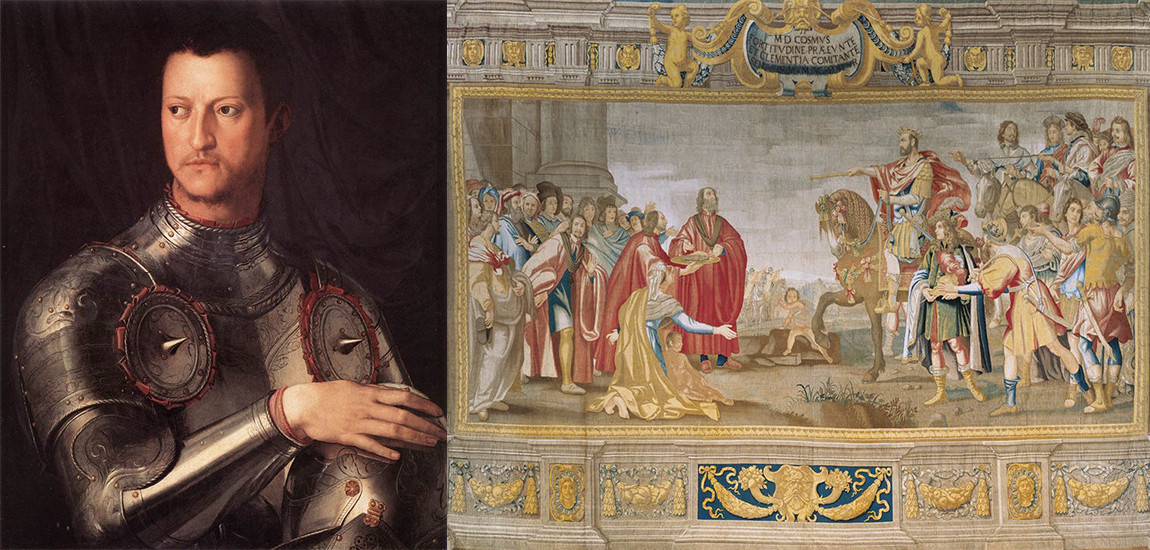
Florence celebrates Cosimo I
This
year we celebrate the 500th anniversary of the birth of Cosimo I de Medici
(1519-1574), the first Grand Duke of Tuscany. Son of the condottiere Giovanni
de 'Medici, known as Giovanni delle Bande Nere, and Maria Salviati, he became
lord of Florence when he was only 17, but was able to create soon a strong
government with the favor of both the Empire and the Church, aiming at
conquering all Tuscany.
Besides being a skilled politician, he was also a great family man, devoted to
his sons and his second wife Eleonora da Toledo, for whom he created one of the
most beautiful palaces of Italy.
Cosimo made art a political tool to promote the image of a wise government,
which brought great wealth to Florence. To him that we owe some of the most
important Florentine structures that forever changed the face of the city: in
1560, to reunite the Florentine magistrates, uffici, in a single building under
his control, he built next to Palazzo della Signoria those that are now the
Uffizi; he had Palazzo Pitti and the Boboli gardens extended and modernized,
and commissioned to Giorgio Vasari the Vasari Corridor that connected the two
structures.
Florence owes a great deal to Cosimo I, man of great intelligence and
ambition, which is why, on the anniversary of his birth, the Uffizi Galleries
celebrate him with three exhibitions: "Cento lanzi per il
Principe",
“Una biografia
tessuta. Gli arazzi seicenteschi in onore di Cosimo
I” and “La prima statua per Boboli. Il Villano restaurato”.
A Hundred Lances for the Prince
The exhibition is dedicated to the German guard of the Medici (Guardia d’Lanzi,
from Lanzichenecco, "Lanzknecht”), sent in 1541 by Emperor Carlo V of
Habsburg as a sign of his support for Cosimo's government.
The Lanzi, from which the famours Loggia took the name, once facade of their
headquarters, had the task of protecting the ruler and those closest to him; a
task they faithfully performed for about 200 years, until the arrival of the
Swiss Lorena Guard that replaced them in 1738.
Characteristic of the soldiers was the iconic bright colored costume, the
halberd, which stands out in all the paintings next to their sovereign.
With over 90 works, including armors, clothes, engravings, paintings and
documents, the exhibition traces the history of the Guardia de 'Lanzi, which
has become an iconic image of princely power. Among the exhibits, are of
particular relevance the few, but decidedly important remains of Cosimo's
armor, so often depicted in his portraits.
Weaving a Biography. 17th century tapestries in honour of Cosimo I
Moving from the Uffizi to Palazzo Pitti, this exhibition recounts the most
important moments in the government of Grand Duke Cosimo I through nine
grandiose tapestries of wool and silk. Set up between the Sala Bianca and the
Sala delle Nicchie, the exhibition recreates the arrangement originally
intended by Ferdinando II for the Sala di Saturno, used for the secret hearings
of the Grand Duke, who paid homage to his predecessor with this series of
tapestries.
An exhibition on tapestries proves to be particularly suitable for celebrating
Cosimo I, as he himself founded the manufactory in 1545, bringing two important
Flemish tapestries to Florence to teach the Florentines this art in which
Flanders excelled.
The First Statue for the Boboli Garden. The Peasant restored
The last of the three exhibitions in honor of Cosimo I focuses on the
restoration of the first statue of Boboli, the Peasant with his Barrel carved around 1557 by Giovanni di Paolo
Fancelli based on a design by the master Baccio Bandinelli. It started a
tradition of statues that represented comon people intent in their daily
affairs; the kind of sculpture that later was called "of genre".
Purchased in 1550 by Cosimo for his consort Eleonora of Toledo, who was not
accustomed to city life and needed fresh air and open spaces, Palazzo Pitti was
the new home of the Grand Dukes replacing what was subsequently called the
Palazzo Vecchio. With its huge garden, Palazzo Pitti became a model for palaces
throughout Europe, and Boboli constitutes one of the first examples of Italian
garden, created right here in Florence and then exported to France; as well as
an important museum of outdoor sculpture.
Therefore, with this trilogy of exhibitions, not only Cosimo I is celebrated,
but so is the city of Florence, of which the first Grand Duke remains one of
the personalities that most marked the history.



